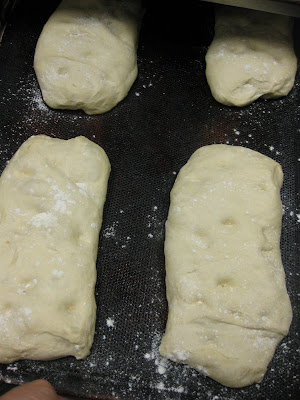 You don't know this, but I have been trying in vain for the past few months to make a ciabatta bread that looks attractive, has a crunchy crust, and a soft interior with the large holes that make ciabatta, ciabatta. I've tried Peter Reinhart's recipe so many times. I've tried random recipes off the internet, I've tried the no-knead bread recipe, and I've tried the "Artisan Bread in 5 min a Day" recipe, all to no avail. They produce pretty tasty bread, but none with the holes I was looking for. Very frustrating, let me tell you.
You don't know this, but I have been trying in vain for the past few months to make a ciabatta bread that looks attractive, has a crunchy crust, and a soft interior with the large holes that make ciabatta, ciabatta. I've tried Peter Reinhart's recipe so many times. I've tried random recipes off the internet, I've tried the no-knead bread recipe, and I've tried the "Artisan Bread in 5 min a Day" recipe, all to no avail. They produce pretty tasty bread, but none with the holes I was looking for. Very frustrating, let me tell you. WELL, I HAVE ARRIVED. I could tell just from the dough that this recipe was the one. It was wet, but still had structure. Even when I turned it out onto the table to divide it, it didn't deflate. The dough was strong, but still developed the gas holes. Killer. Thrilling. I'm beside myself with joy. Thank you King Arthur Flour. Thank you, thank you, thank you.
In a selfish way, I'm almost reticent to share this with you, considering what I went through to get here...bu I've decided to save you pain. And King Arthur has tons of baller recipes.
I made only a few changes to this recipe, noted in the ingredients.
First, you must stir up a pre-ferment that will sit overnight, developing flavor. Mix these ingredients together and let sit for 10-15 hours until very, very bubbly.
1 1/2 cups (6 1/4 oz) bread flour or King Arthur AP flour
1 cup (8 oz) cool water
1/16 t instant yeast
When ready to mix the dough, combine the pre-ferment and the rest of the ingredients in the bowl of a mixer.
all of the starter (pre-ferment)
1 t instant yeast
1 1/2 cup (6 1/4 oz) bread flour or King Arthur AP flour
1 1/4 tsp salt
1 tsp sugar
1 tbs nonfat dry milk*
1/4 cup (2 oz) water*
2 tbs (7/8 oz) olive oil
(*instead of the dry milk and water, I just used 1/4 cup milk)
It's important you use a mixer because the dough is so soft (basically impossible to knead by hand).

These pictures show the recipe multiplied by 8
Beat at medium speed using the paddle attachment. I had to switch to the dough hook after a few minutes because the dough climbed up onto the paddle and clung there like a frightened monkey. When sufficiently mixed, the dough will be gorgeously smooth and elastic. It took more like 10 minutes in my big mixer.

Look at that gluten development! See how stretchy and shiny it is!!

Place the dough in a greased bowl and set aside to rise. After one hour, stretch each side and fold over the middle, then turn the whole thing upside-down so the seams are on the bottom.

folded dough
Let rise one more hour (two hours total rising time, with the folding in the middle)

fully risen dough
Gently turn the dough out onto a floured surface (no need to go nuts with the flour. This dough isn't as sticky and gloppy as some of the no-knead recipes).

Use a knife to divide the dough into 2 loaves, or smaller bits for sandwiches. (K.A. website says for the two loaves, you should have two fat logs, about 10"x4").
Gently transfer the dough to a baking sheet, stretching them out slightly, leaving about 4" between them.

Allow to rise for 60-90 minutes, dimpling with your fingers halfway through. You can push your fingers almost to the bottom of the loaves, the holes will fill partially back up. Preheat the oven to 425 degrees about 20 minutes before baking time.
Spritz the loaves with luke warm water (to help create steam) and bake until golden brown, about 18-20 minutes. You can also create steam by placing a rimmed baking sheet in the oven during preheat and pouring hot water onto it just before loading the loaves in the oven. Steam is necessary to facilitate proper "oven spring" (the sudden burst of yeast activity and loaf expansion when hit with the heat of the oven) and the development of a proper crust.
 Great Scott this is good bread! Eric and I cut it in half lengthwise, toast it and eat bruschetta on it practically every Sunday. We're about to eat some now, in fact. Just combine diced tomatoes, minced garlic, lemon juice, olive oil and fresh chopped basil, then spread it on the toasted ciabatta bread. Add some mozzarella if you like. The crust gets crunchy and the interior stays soft. YUM.
Great Scott this is good bread! Eric and I cut it in half lengthwise, toast it and eat bruschetta on it practically every Sunday. We're about to eat some now, in fact. Just combine diced tomatoes, minced garlic, lemon juice, olive oil and fresh chopped basil, then spread it on the toasted ciabatta bread. Add some mozzarella if you like. The crust gets crunchy and the interior stays soft. YUM.

I am going to HAVE to make this bread!!
ReplyDeletelet me know how it turns out!
ReplyDeletei feel like i should tell you that after you left the other night...i went to sleep. i woke up the next morning and realized we'd left the errrm "well aged" ciabatta bread out on the counter. so i chopped off a hunk and nibbled on it.
ReplyDelete